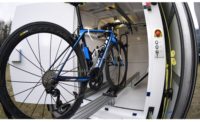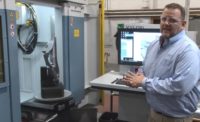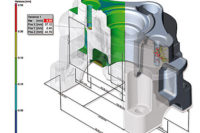The concept of the mobile radiography darkroom has been around for decades. Applications are broad, and when it comes to real-life practice, ingenuity reigns.
Job contracts extending over long periods often employ a trailer converted to a lab. Parked at the job site, the unit requires no re-spotting or the expense of daily transit back to the shop. Some of these units even split the space with a revolving door to provide office as well as darkroom areas, eliminating the shift between work stations and associated down time.
In more extreme instances, ocean shipping containers have been converted to darkrooms. These configurations are rugged and durable, but also heavy and difficult to handle at the job site. Container-housed darkrooms have been used in such diverse geographies as the Sahara Desert in North Africa and Trinidad in the Caribbean, and in some instances have been mounted on skids and pulled across sand or soil to various test sites. Although a number of variations in the mobile darkroom concept exist, the configuration most widely used is the tried-and-true camper-style truck-mounted unit.
NDT accelerates change
While the truck-mounted configuration is essentially a box on wheels-the basic parameters of which have not changed significantly since its inception-methods and materials of construction have evolved over the years, taking advantage of new processes and products and leading to advances in durability and performance.
The increasing application of digital imaging, as well as other methods of nondestructive testing (NDT), will surely bring about and accelerate further changes as the mobile darkroom strives to accommodate these and other emerging technologies. The most common uses for truck-mounted units are refinery and pipeline testing, but other venues such as aircraft inspection also are fairly common.
Construction methods
Two primary methods of construction are familiar to most in the industry, the wood-frame unit and the fiberglass lay-up. The typical wood-frame unit with interior paneling and exterior "skin" is common. Variations on this theme include different interior materials such as laminated surfaces, providing greater durability and smooth exterior surfaces such as fiberglass or flat metal panels, which can be more appealing and easy to customize with graphics. When considering flat exterior skin, however, manufacturers should keep in mind that repairs can be involved and costly, and durability may be less than that of typical sectioned aluminum siding.
The other common construction is fiberglass lay-up. Much like a boat, the resin and glass strand exterior structure is hand-laid or "chop gunned," and although strong, is heavy, susceptible to cracking and often expensive to repair. Variations on basic construction methods include tube frames, usually steel, but the future will see aluminum frames with either aluminum siding or fiberglass sheet. Aluminum frames with composite walls-typically a sandwich of panel, foam and fiberglass skin-also show promise.
Storage and flooring
After the basic consideration of the frame, interior build-out centers on one crucial focal point: storage. More is better. Cabinets and drawers make all the difference in how well a unit is received by those in the field. When comparing manufacturers, it is helpful to examine hinges, latches and handles. Is the hardware durable enough for the rigors of field work? Are the storage compartments large enough?
Cabinetry should be made of durable material such as plywood, preferably a hardwood like mahogany, because particle board will not hold up in wet environments. Tough facings are part of durability, too. Formica has a consistent surface and is easy to clean. Melamine is a thinner surface and more susceptible to damage. In all facings, low-scratch resistance or brittle surfacing should be avoided.
Flooring, a common source of problems in the mobile darkroom, varies. Ranging from a painted surface to a fiberglass "tub," many types can be found in the marketplace. While rolled or brushed coatings generally do not hold up well, a sprayed surface-type coating is tough and resilient, as is industrial rubber flooring.
Modern rubber sheeting has made huge strides in durability. For example, the advent of urethane has resulted in a product made of recycled car tires. Tires are ground up to a crumb-like consistency, mixed with urethane, cured in a tube-shaped drum and shaved like a plywood core into sheets. The resulting product is used in gyms, health clubs, garages, industrial work locations and, of course, mobile darkrooms.
For all types of floors, it is crucial that the seams be adequately sealed. It is even more advantageous for the floor to be seamless. Beyond this, the floor should be made of a material that resists cracking, splitting and punctures.
Lighting and other factors
When considering the lighting and electrical aspects of the unit, flexibility makes for a better work station. A variety of light sources allows for separate steps in the task process. Over-counter lights, ceiling lights, porch lights and floodlights make for a safer and less mistake-prone environment. Given the harsh conditions of a pipeline project, for example, floodlights make a world of difference in working around the mobile unit.
The unit should include a comprehensive system with adequate receptacles-12-volt DC and 120-volt AC-and a converter with onboard battery storage and charging. Driving between locations or connecting to shore power should charge the auxiliary 12-volt-deep cycle battery.
Generator compartments are either an integral necessity or an unwanted option. Many manufacturers prefer a bumper-mounted generator or none at all-they use available shore power-and space allocated for generator storage is addressed as an extra storage compartment. Many manufacturers allow either consideration for a specific location. If not a generator compartment, cabinets may be made accessible from the exterior, and outside storage of dirty, wet and heavy items is easier and less obtrusive to the inside work area. Cable reels, tools and boots are good candidates for this type of facility.
Weather conditions dictate the need for air conditioning, heat or both. Air conditioners are located on the roof or the back wall. If on the roof, it is important to consider where the unit will be deployed to avoid overhangs, branches and other obstacles that can shave off a unit. Rear wall units, which can be easily and cost-effectively replaced, can serve in many applications.
Developing tanks are pivotal in the performance of the unit. Fiberglass and plywood tanks serve as the benchmark of the industry. Despite their great weight, they have performed well over time. New tanks made of materials such as polyethylene also show promise. They are of lighter weight, more easily handled and allow for simple valve replacement and overall ease of repair.
Other factors to consider include weight and wind resistance, both of which affect the truck towing the unit. Lighter units will have less impact on gas mileage and a more streamlined profile. Over the life of the unit and the trucks it travels on, a more lightweight unit can pay for itself. Lighter weight, lower-profile units are particularly indicated for job sites in harsh geographies. Working a pipeline in the densely wooded Northwest is a good illustration. The cabover portion of the unit provides not only streamlining but storage.
The options
Base cost is just the beginning. It is important to factor in what options or modifications will be needed to put the unit in active service, and how quickly any outfitting can be completed by the manufacturer or purchasing company. In some cases, it is not simply the list of desired options that makes the unit suited for the job; the layout itself might facilitate the specific tasks the technicians will be performing.
Consider this when embarking on a new unit purchase:
• How large a unit is needed?
• Where will it be used?
• What construction type works best for a manufacturer's needs?
• Is weight a consideration?
• Does the unit need to be transferred from truck to truck?
• What are the real budget and cost
considerations?
• Are the available options adequate?
• Is customizing available?
• Is the unit repairable if necessary? Are replacement parts readily available?
• Does the unit fit the technician's needs?
While the practice of mobile radiography continues to evolve alongside strides being made in imaging technology, the future promises many more years of developing film in the field. Careful consideration of the aforementioned factors can help guide companies striving to balance the conceptual advances on the horizon with the day-to-day realities of the field. NDT








